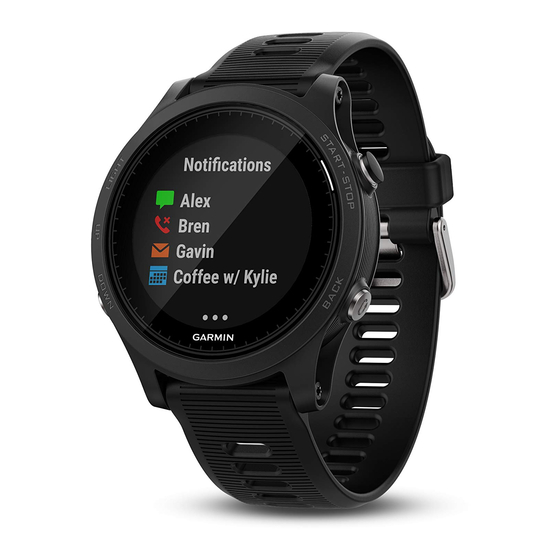Garmin FORERUNNER 935 Benutzerhandbuch - Seite 17
Blättern Sie online oder laden Sie pdf Benutzerhandbuch für Siehe Garmin FORERUNNER 935 herunter. Garmin FORERUNNER 935 46 Seiten.
Auch für Garmin FORERUNNER 935: Benutzerhandbuch (42 seiten)

2
Wet the electrodes
on the back of the heart rate monitor to
create a strong connection between your chest and the
transmitter.
3
Wear the heart rate monitor with the Garmin logo facing right-
side up.
The loop
and hook
side.
4
Wrap the heart rate monitor around your chest, and connect
the strap hook to the loop.
NOTE: Make sure the care tag does not fold over.
After you put on the heart rate monitor, it is active and sending
data.
Data Storage
The heart rate monitor can store up to 20 hours of data in a
single activity. When the heart rate monitor memory is full, your
oldest data is overwritten.
You can start a timed activity on your paired Forerunner device,
and the heart rate monitor records your heart rate data even if
you move away from your device. For example, you can record
heart rate data during fitness activities or team sports where
watches cannot be worn. Your heart rate monitor automatically
sends your stored heart rate data to your Forerunner device
when you save your activity. Your heart rate monitor must be
active and within range (3 m) of the device while data is
uploaded.
Caring for the Heart Rate Monitor
A buildup of sweat and salt on the strap can decrease the ability
of the heart rate monitor to report accurate data.
• Rinse the heart rate monitor after every use.
• Hand wash the heart rate monitor after every seven uses or
one pool swim, using a tiny amount of mild detergent, such
as dishwashing liquid.
NOTE: Using too much detergent may damage the heart rate
monitor.
• Do not put the heart rate monitor in a washing machine or
dryer.
• When drying the heart rate monitor, hang it up or lay it flat.
Tips for Erratic Heart Rate Data
If the heart rate data is erratic or does not appear, you can try
these tips.
• Reapply water to the electrodes and contact patches (if
applicable).
• Tighten the strap on your chest.
• Warm up for 5 to 10 minutes.
• Follow the care instructions
Monitor, page
11).
Heart Rate Features
connection should be on your right
NOTICE
(Caring for the Heart Rate
• Wear a cotton shirt or thoroughly wet both sides of the strap.
Synthetic fabrics that rub or flap against the heart rate
monitor can create static electricity that interferes with heart
rate signals.
• Move away from sources that can interfere with your heart
rate monitor.
Sources of interference may include strong electromagnetic
fields, some 2.4 GHz wireless sensors, high-voltage power
lines, electric motors, ovens, microwave ovens, 2.4 GHz
cordless phones, and wireless LAN access points.
Running Dynamics
You can use your compatible Forerunner device paired with the
HRM-Tri accessory or other running dynamics accessory to
provide real-time feedback about your running form. If your
Forerunner device was packaged with the HRM-Tri accessory,
the devices are already paired.
The running dynamics accessory has an accelerometer that
measures torso movement in order to calculate six running
metrics.
Cadence: Cadence is the number of steps per minute. It
displays the total steps (right and left combined).
Vertical oscillation: Vertical oscillation is your bounce while
running. It displays the vertical motion of your torso,
measured in centimeters.
Ground contact time: Ground contact time is the amount of
time in each step that you spend on the ground while
running. It is measured in milliseconds.
NOTE: Ground contact time and balance are not available
while walking.
Ground contact time balance: Ground contact time balance
displays the left/right balance of your ground contact time
while running. It displays a percentage. For example, 53.2
with an arrow pointing left or right.
Stride length: Stride length is the length of your stride from one
footfall to the next. It is measured in meters.
Vertical ratio: Vertical ratio is the ratio of vertical oscillation to
stride length. It displays a percentage. A lower number
typically indicates better running form.
Training with Running Dynamics
Before you can view running dynamics, you must put on the
HRM-Run
™
accessory, HRM-Tri accessory, or Running
Dynamics Pod, and pair it with your device
Sensors, page
22).
If your Forerunner was packaged with the heart rate monitor, the
devices are already paired, and the Forerunner is set to display
running dynamics.
1
Select START, and select a running activity.
2
Select START.
3
Go for a run.
4
Scroll to the running dynamics screens to view your metrics.
(Pairing ANT+
11
